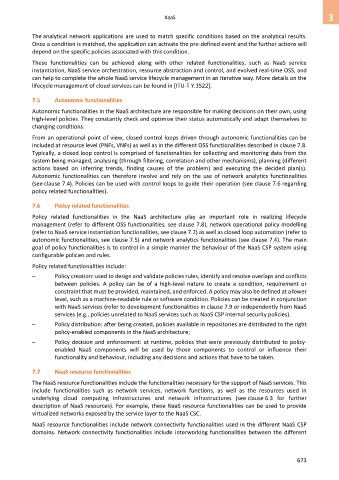Page 681 - Cloud computing: From paradigm to operation
P. 681
XaaS 3
The analytical network applications are used to match specific conditions based on the analytical results.
Once a condition is matched, the application can activate the pre-defined event and the further actions will
depend on the specific policies associated with this condition.
These functionalities can be achieved along with other related functionalities, such as NaaS service
instantiation, NaaS service orchestration, resource abstraction and control, and evolved real-time OSS, and
can help to complete the whole NaaS service lifecycle management in an iterative way. More details on the
lifecycle management of cloud services can be found in [ITU-T Y.3522].
7.5 Autonomic functionalities
Autonomic functionalities in the NaaS architecture are responsible for making decisions on their own, using
high-level policies. They constantly check and optimize their status automatically and adapt themselves to
changing conditions.
From an operational point of view, closed control loops driven through autonomic functionalities can be
included at resource level (PNFs, VNFs) as well as in the different OSS functionalities described in clause 7.8.
Typically, a closed loop control is comprised of functionalities for collecting and monitoring data from the
system being managed, analysing (through filtering, correlation and other mechanisms), planning (different
actions based on inferring trends, finding causes of the problem) and executing the decided plan(s).
Autonomic functionalities can therefore involve and rely on the use of network analytics functionalities
(see clause 7.4). Policies can be used with control loops to guide their operation (see clause 7.6 regarding
policy related functionalities).
7.6 Policy related functionalities
Policy related functionalities in the NaaS architecture play an important role in realizing lifecycle
management (refer to different OSS functionalities, see clause 7.8), network operational policy modelling
(refer to NaaS service instantiation functionalities, see clause 7.2) as well as closed loop automation (refer to
autonomic functionalities, see clause 7.5) and network analytics functionalities (see clause 7.4). The main
goal of policy functionalities is to control in a simple manner the behaviour of the NaaS CSP system using
configurable policies and rules.
Policy related functionalities include:
– Policy creation: used to design and validate policies rules, identify and resolve overlaps and conflicts
between policies. A policy can be of a high-level nature to create a condition, requirement or
constraint that must be provided, maintained, and enforced. A policy may also be defined at a lower
level, such as a machine-readable rule or software condition. Policies can be created in conjunction
with NaaS services (refer to development functionalities in clause 7.9 or independently from NaaS
services (e.g., policies unrelated to NaaS services such as NaaS CSP internal security policies).
– Policy distribution: after being created, policies available in repositories are distributed to the right
policy-enabled components in the NaaS architecture;
– Policy decision and enforcement: at runtime, policies that were previously distributed to policy-
enabled NaaS components will be used by those components to control or influence their
functionality and behaviour, including any decisions and actions that have to be taken.
7.7 NaaS resource functionalities
The NaaS resource functionalities include the functionalities necessary for the support of NaaS services. This
include functionalities such as network services, network functions, as well as the resources used in
underlying cloud computing infrastructures and network infrastructures (see clause 6.3 for further
description of NaaS resources). For example, these NaaS resource functionalities can be used to provide
virtualized networks exposed by the service layer to the NaaS CSC.
NaaS resource functionalities include network connectivity functionalities used in the different NaaS CSP
domains. Network connectivity functionalities include interworking functionalities between the different
673

